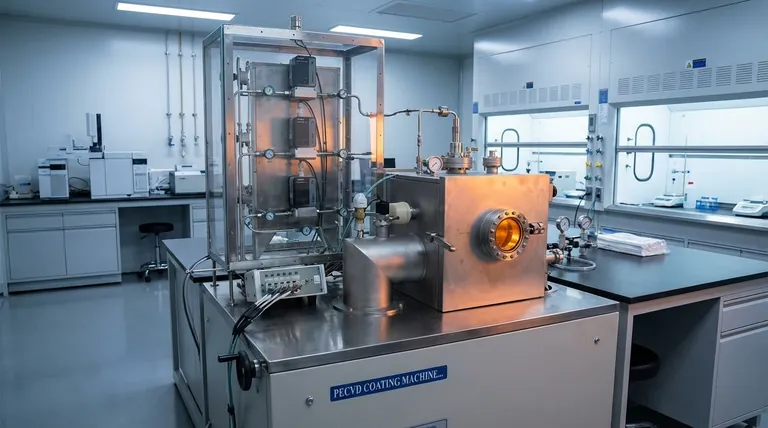At its core, Chemical Vapor Deposition (CVD) is a foundational manufacturing process used to create high-performance thin films and advanced materials. Its applications span from the heart of the electronics industry, where it is used to build microchips, to the creation of durable, corrosion-resistant coatings for industrial and biomedical uses, and even the synthesis of novel materials like lab-grown diamonds.
The true significance of CVD is not just in what it makes, but how it makes it. It is a platform technology that gives engineers the power to build materials atom-by-atom, unlocking properties and performance levels that are unattainable with other methods.

The Foundation of Modern Electronics
CVD is an indispensable process in the semiconductor industry. The fabrication of virtually every modern integrated circuit relies on its ability to deposit pristine, uniform layers of material onto silicon wafers.
Depositing Critical Insulating Layers
CVD is the standard method for applying thin films that act as insulators or dielectrics. Materials like silicon dioxide and silicon nitride are deposited to electrically isolate different components on a chip, which is fundamental to its operation.
Building Intricate Microstructures
The process is precise enough to fill incredibly small, complex geometries. This is essential for modern chip designs, such as filling deep trenches with insulating material (TEOS or HTO) to create the three-dimensional structures of advanced processors and memory.
Engineering Advanced Materials and Surfaces
Beyond semiconductors, CVD is a versatile tool for enhancing the properties of existing materials and creating entirely new ones from the ground up.
Creating High-Performance Coatings
CVD is used to apply coatings that dramatically improve a material's corrosion and wear resistance. These durable and often lubricious coatings protect everything from industrial cutting tools to engine components, extending their operational life.
Enabling Biomedical Innovation
The ability to produce high-quality, corrosion-resistant, and biocompatible coatings makes CVD ideal for medical applications. It is commonly used to coat biomedical device implants, ensuring they can function safely and reliably within the human body.
Synthesizing Next-Generation Materials
CVD is at the forefront of materials science research and production. It is a primary method for growing low-dimensional materials like carbon nanotubes and is a leading technique for producing high-quality, high-clarity lab-grown diamonds.
Producing Diverse Material Forms
The versatility of the CVD process is not limited to thin coatings. It can also be adapted to form foils, powders, composite materials, free-standing bodies, and even microscopic filaments and whiskers for specialized applications.
Understanding the Key Advantages
Choosing a manufacturing process always involves trade-offs. CVD is often selected because its specific advantages align perfectly with the demands of high-technology applications.
Precision and Purity
CVD allows for exceptional control over the final product. It can create films ranging from a single atomic layer to several microns thick and provides precise control over chemical impurities, which is critical for both semiconductors and high-quality lab-grown diamonds.
Scalability and Versatility
The process can be used to grow materials over large areas and on a variety of different base materials, or substrates. This makes it a highly scalable and adaptable solution for industrial production.
Favorable Production Conditions
Compared to competing technologies like High-Pressure/High-Temperature (HPHT) for diamond synthesis, CVD often has advantages. It operates at much lower pressure (under 27 kPa) and can have lower equipment set-up costs, making it more accessible and economical for certain applications.
Applying This to Your Goal
Your interest in CVD's applications likely stems from a specific field. Understanding its core strengths will help you identify its relevance to your work.
- If your primary focus is semiconductor manufacturing: Recognize CVD as the essential process for depositing the ultra-pure insulating films that make microchips possible.
- If your primary focus is materials engineering: View CVD as a powerful tool for enhancing surface properties or synthesizing novel materials with tailored characteristics.
- If your primary focus is commercial production (e.g., lab diamonds): See CVD as a scalable and cost-effective method for growing high-purity, high-clarity crystalline materials without requiring extreme physical conditions.
Ultimately, Chemical Vapor Deposition is a cornerstone technology that enables us to engineer the world from the atomic level up.
Summary Table:
| Application Area | Key Uses |
|---|---|
| Electronics | Microchip fabrication, insulating layers (SiO₂, SiN), 3D structures |
| Coatings | Corrosion/wear-resistant surfaces, industrial tools, engine parts |
| Biomedical | Biocompatible coatings for implants, medical devices |
| Materials Science | Carbon nanotubes, lab-grown diamonds, foils, powders |
| Advantages | Atomic-level precision, high purity, scalability, lower pressure/cost |
Ready to leverage CVD technology for your lab? KINTEK specializes in providing high-quality lab equipment and consumables tailored for advanced material synthesis and thin-film deposition. Whether you're developing next-generation semiconductors, durable coatings, or innovative materials, our solutions are designed to enhance your research and production efficiency. Contact our experts today to discuss how we can support your specific laboratory needs!
Visual Guide

Related Products
- Inclined Rotary Plasma Enhanced Chemical Vapor Deposition PECVD Equipment Tube Furnace Machine
- HFCVD Machine System Equipment for Drawing Die Nano-Diamond Coating
- 915MHz MPCVD Diamond Machine Microwave Plasma Chemical Vapor Deposition System Reactor
- Vacuum Hot Press Furnace Machine for Lamination and Heating
- Laboratory CVD Boron Doped Diamond Materials
People Also Ask
- What is plasma in CVD process? Lowering Deposition Temperatures for Heat-Sensitive Materials
- What is plasma enhanced chemical vapour deposition process? Unlock Low-Temperature, High-Quality Thin Films
- What materials are deposited in PECVD? Discover the Versatile Thin-Film Materials for Your Application
- What is PECVD silicon deposition? Achieve Low-Temperature, High-Quality Thin Films
- What is the difference between PECVD and CVD? Unlock the Right Thin-Film Deposition Method



















